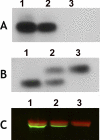The Leishmania donovani UMP synthase is essential for promastigote viability and has an unusual tetrameric structure that exhibits substrate-controlled oligomerization
- PMID: 21507942
- PMCID: PMC3121495
- DOI: 10.1074/jbc.M111.228213
The Leishmania donovani UMP synthase is essential for promastigote viability and has an unusual tetrameric structure that exhibits substrate-controlled oligomerization
Abstract
The final two steps of de novo uridine 5'-monophosphate (UMP) biosynthesis are catalyzed by orotate phosphoribosyltransferase (OPRT) and orotidine 5'-monophosphate decarboxylase (OMPDC). In most prokaryotes and simple eukaryotes these two enzymes are encoded by separate genes, whereas in mammals they are expressed as a bifunctional gene product called UMP synthase (UMPS), with OPRT at the N terminus and OMPDC at the C terminus. Leishmania and some closely related organisms also express a bifunctional enzyme for these two steps, but the domain order is reversed relative to mammalian UMPS. In this work we demonstrate that L. donovani UMPS (LdUMPS) is an essential enzyme in promastigotes and that it is sequestered in the parasite glycosome. We also present the crystal structure of the LdUMPS in complex with its product, UMP. This structure reveals an unusual tetramer with two head to head and two tail to tail interactions, resulting in two dimeric OMPDC and two dimeric OPRT functional domains. In addition, we provide structural and biochemical evidence that oligomerization of LdUMPS is controlled by product binding at the OPRT active site. We propose a model for the assembly of the catalytically relevant LdUMPS tetramer and discuss the implications for the structure of mammalian UMPS.
Figures










References
-
- Connolly G. P., Duley J. A. (1999) Trends Pharmacol. Sci. 20, 218–225 - PubMed
-
- Evans D. R., Guy H. I. (2004) J. Biol. Chem. 279, 33035–33038 - PubMed
-
- Jones M. E. (1980) Annu. Rev. Biochem. 49, 253–279 - PubMed
-
- Carter N. S., Rager N., Ullman B. (2003) in Molecular and Medical Parasitology (Marr J. J., Nilsen T., Komuniecki R. eds) pp. 197–223, Academic Press Limited, London
-
- Weber G. (2001) Biochemistry 66, 1164–1173 - PubMed
Publication types
MeSH terms
Substances
Associated data
- Actions
- Actions
Grants and funding
LinkOut - more resources
Full Text Sources

